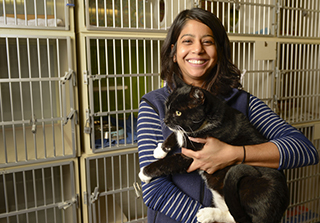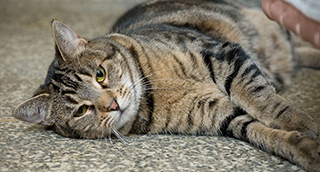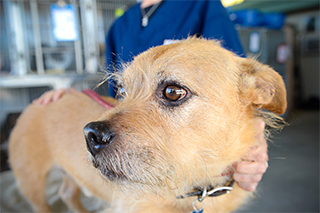Information & Impacts
Recent Accomplishments
Dr. Kate Hurley received the Maddie’s Hero Award in the category of Big Picture thinking in April 2017. The award, a first of its kind, comes with a $10K grant for awardees’ organizations. It also recognizes and honors the "top dogs" in communities that are advancing the welfare of companion animals in the United States as well as leading the way with innovative ideas, progressive thinking and lifesaving actions. Exemplifying Maddie's Fund's core values of honesty, integrity and mutual respect, these individuals are making a difference in the lives of homeless dogs and cats and are deserving of incredible recognition.
KSMP’s largest campaign, The Million Cat Challenge, continues to advance towards its goal of saving one million cats in five years, with over 800,000 lives saved to date.
In the spring of 2017 KSMP worked with the LA South City Shelter to place portals in all cat housing. Portals are one of the most effective ways to reduce stress and disease in shelters as well as increase adoption rates for homeless animals.
To date, KSMP has trained 150 students in spay/neuter through our partnership with Yolo Animal Services.
Dr. Hurley, Dr. Karsten, and Dr. Wagner have received the CFHS Animal Welfare Innovation and Leadership Award for the creation of the Capacity for Care program which reduces cat populations and saves millions of lives.
In 2015 Dr. Kate Hurley became one of the first veterinarians boarded in Shelter Medicine by the American Board of Veterinary Practitioners.
Here are some examples of our research and the impact it has on companion animal health
With infectious diseases, there is no time to wait
Since the 1940s, veterinarians have known that the vaccine for distemper in dogs works within four hours, and the fast-acting nature of this vaccination can mean the difference between life and death. But nobody thought to provide this information to animal shelter staff. Who knows how many animals needlessly died as a result?

The Koret Shelter Medicine Program has led the way in educating shelter personnel about the need to vaccinate against this deadly infectious disease as soon as an animal comes through the door. There’s no time to wait. “Our job is to bring solutions — some already existing, some still waiting to be discovered — to those working to save these animals,” says Dr. Denae Wagner, a staff veterinarian in the program.
Infectious diseases, such as distemper, are caused by pathogens, including bacteria, viruses, parasites or fungi, which spread from one animal to another. Our program has worked with shelters to help prevent and treat these diseases since its launch in 2001. Take, for example, upper respiratory infection: URI has long been the most commonly encountered illness in animal shelters, and a common reason for euthanasia in otherwise healthy, adoptable cats. The virus spreads so easily and rapidly that controlling the disease can become unmanageable even for well-resourced shelters. After Wagner and Dr. Kate Hurley, director of the Koret Shelter Medicine Program, discovered the correlation between increased housing space and a significant reduction in URI, the two also devised a simple solution — a PVC pipe that costs about $12. The pipe can be installed to join existing cages, giving cats the extra space they need to stay healthy and happy long enough to find a new home.
The shelter medicine team has also been on the forefront of curbing strep zoo, a horrific infectious disease that eats away at lung tissue; a dog can be healthy in the morning and drop dead in the afternoon. Pathologist Dr. Patricia Pesavento worked with the shelter medicine team to identify the bacteria that caused a deadly outbreak of strep zoo at a Las Vegas shelter. Nearly 4,000 dogs had died by the time the Davis crew arrived on scene. They designed a plan for blanketing the population with penicillin, which kills the bacteria, at the first sign of sickness. This solution costs less than $5 an animal, and can stop an outbreak in its tracks.
Shelters see so many animals that veterinarians there can notice patterns or outbreaks emerge much quicker than in a veterinary clinic. In this way, shelters can partner with veterinary schools and researchers by providing their observations; in return, shelters can access tools and education on how to address problems. This relationship has proved successful many times. Hurley recalls one time when the director of a big-city animal shelter was set to start her new job and a dog dropped dead in a manner that resembled strep zoo; this soon-to-be director had heard Hurley speak at a conference and recognized the signs. She immediately called up her new workplace and advised them to treat all the dogs in their care with penicillin. The director turned out to be correct, and numerous dogs were saved as a result.
- TOP -
Shelter animals benefit from enrichment areas
Both cats and dogs in a shelter setting benefit greatly from opportunities for enrichment. Even when housing quality is good, providing space outside of their cages or kennels for exercise, play and interaction with people and other animals has many upsides. Enrichment space is even more urgent when a shelter has small cages or the length of stay for a typical animal extends beyond a week or two.

The Koret Shelter Medicine Program at the CCAH is a major proponent of providing areas for out-of-cage time, which they say can be incorporated into a shelter design plan and often retrofitted into an existing structure. For example, cats can be out of their cages in a sufficiently large enclosure within a room, an outdoor area enclosed by fencing or in a designated room; a “get-acquainted” room can function as an enrichment area when the shelter is closed to the public. Dogs tend to enjoy outdoor play areas and walking trails, but also benefit from quiet out-of-cage time in a home-like, indoor setting. This helps the dogs practice quiet indoor behavior — while a volunteer or staff reads or watches TV—and enhances the likelihood that the animals will be adopted. It also provides a welcome break from the hustle and bustle of the shelter or kennel.
Our shelter medicine staff recommends that shelters construct and furnish enrichment out-of-cage areas so they can be easily disinfected. If structures for out-of-cage time such as play towers are placed within cat rooms, ideally place them at least 5 feet from the front of cages to prevent droplet transmission of disease. In order to protect animal health and ensure that out-of-cage time relieves stress and enhances wellness, there are some caveats to consider: Animals should be screened prior to using these spaces, and their health history, age and vaccine history, and temperament should be taken into consideration. The sanitation of the space is also of the utmost importance.
Allowing an animal to learn, explore and exhibit natural behaviors is paramount to mental wellbeing and increases their adoptability. Preparing games, food puzzles and enrichment toys is an excellent activity for shelter volunteers and does not need to break the bank or eat into staffing hours. A strapped shelter can curb boredom with minor variations in everyday activities. For example, instead of feeding dogs one large meal a day, enlist volunteers to prepare two small meals served in a frozen Kong with peanut butter. Save wine corks, milk caps and toilet paper rolls for cats to bat. Added bonus: Studies show adopters spend more time looking at animals that have toys in their enclosures, regardless of whether they are playing with them or not. Visit www.sheltermedicine.com for more information on how we are working to make shelters better.
- TOP -
 Putting a stop to feline upper-respiratory infection
Putting a stop to feline upper-respiratory infection
For several decades, many animal shelters across the United States had a bad reputation for adopting out cats sick with feline upper-respiratory infection (URI). That’s because if a cat didn’t get adopted quickly, the animal would likely get URI, a highly contagious disease accompanied by sniffling, sneezing and lethargy. Basically, it’s the cat equivalent of a cold, most commonly caused by a virus. Shelters would often euthanize infected cats because people don’t want to adopt sick animals.
Feline herpesvirus accounts for a large percentage of all contagious URIs. It’s triggered by pregnancy and birthing, meaning the disease gets passed onto kittens. It’s also prompted by stress, increased when a cat moves into a shelter and is then confined to a small, metal cage, its litter box located only a few inches from its food and water. “URI is actually activated by typical shelter housing,” says Dr. Kate Hurley, director of the Koret Shelter Medicine Program. “Just about every shelter in the United States in the past decades was built in a way that makes this disease almost inevitable.” Shelters didn’t realize that the prevalence of URI was a byproduct of the facility’s design and layout.
By 2007, Hurley and her colleague Dr. Denae Wagner turned their attention to curbing the spread of feline URI. They enrolled nine shelters in a study, tracing every case of URI for a year. Their findings showed that the amount of floor space in a cat’s housing for the first seven days of its time at the shelter had a huge impact on whether or not a cat got sick. They found that doubling the floor space and providing a two-compartment cage — thereby separating the food and water from the litter box, and reducing stress — resulted in a 50-fold reduction in risk per cat per day. The veterinarians cut holes in cages and connected them with PVC pipes, allowing cats more space to roam.
This process of “portalizing” cages could save millions of cats. But a problem remained: Shelters were euthanizing animals due to lack of space, and were therefore unlikely to agree to cut their number of housing units by half. The veterinarians developed a system called “Capacity for Care.” This refers to having only as many cats in the system at any one time as can move through before they get stressed or sick. The same number can be cared for over time by portalizing cages. With plenty of space to relax and a bedroom compartment separate from the bathroom, cats remain healthy and get adopted quickly. The program now manufacturers these portals and consults with shelters on how to practice “Capacity for Care.”
Hurley remembers a time recently when she visited a shelter once heavily impacted by feline URI — and stood outside the empty isolation room. The cats were no longer getting sick.
- TOP -
Canine infectious respiratory disease complex a big concern in shelters

Canine infectious respiratory disease complex (CIRDC) is, as its name suggests, a complex syndrome of viral and bacterial pathogens that causes significant concern in any multi-dog setting, like an animal shelter or boarding facility. The appropriate treatment and containment practices needed to address a CIRDC incident exist and can be costly to a shelter and to animal welfare, which is why a prevention strategy is critical in a shelter setting.
While “kennel cough,” “infectious tracheobronchitis” and “canine infectious respiratory disease complex” are often used interchangeably, doing so simplifies the complexity of this syndrome. The disease, for example, does not always manifest as simply coughing. Clinical signs of CIRDC may include sneezing, nasal and ocular discharge and sometimes lower respiratory or systemic disease.
Researchers with the Koret Shelter Medicine Program at the CCAH are still unraveling the complicated etiology (causes) of CIRDC. What we do know is that high-density environments, such as shelters — where exposure, susceptibility and transmission of infectious diseases are amplified — can contribute to outbreaks of known CIRDC pathogens, as well as the emergence of new pathogens. Managing CIRDC requires the knowledge gained from past and current research to continually define the role of these pathogens.
Environmental factors and host immune response play an equally important role in causing CIRDC to develop. There is a reason it has been called “kennel cough” – several of the pathogens involved are insufficient to alone cause disease without the additional stress, high-contact rates and crowding often associated with kenneling.
As with other infectious conditions in shelter animals, strategies for preventing CIRDC rely on supporting the animal’s ability to ward off disease, which includes vaccination, stress reduction and prevention of airway irritation by minimizing barking and cleaning in such a way that airborne irritants are reduced. Environmental contaminants must also be reduced, by avoiding crowding, implementing effective sanitation protocols and maintaining good air quality. To learn more, visit www.sheltermedicine.com.
- TOP -
